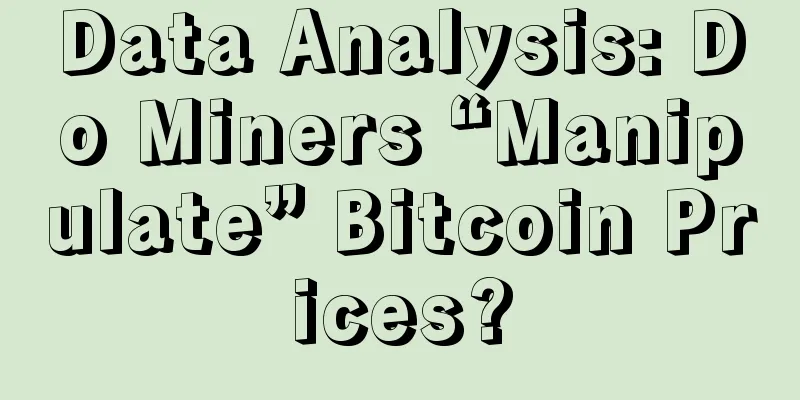Data Analysis: Do Miners “Manipulate” Bitcoin Prices?

|
The latest data shows that miners may be the driving force behind the sharp fluctuations in Bitcoin prices. Miners sold off before bottoming out
On October 11, blockchain analysis company Token Analyst released its latest analysis on social media, saying that miners selling Bitcoin directly affected its price trend. This statement was well supported last year. At the end of last year, when BTC fell to $3,100, there was a massive sell-off. A large number of Bitcoins were transferred to exchanges in June and August, which "further depressed the price." “We found that miners took advantage of market volatility with the Bitcoin they mined, then sold off during periods of large price swings,” Token Analyst concluded. The data builds on research from earlier in August by Elias Simos, senior research analyst at Decentral Park, who tracked where bitcoin mining rewards go and found that more individual miners shared those coins before the 2016 block reward halving. The Three Eras of Mining
Let’s take a look at what Elias Simos’s research says (the following is compiled by Odaily Planet Daily based on Twitter content): The figure below shows the distribution of block rewards received by miners since the first BTC block was mined. Here it is divided into 3 different stages of development: 1) The hobbyist era 2) The exploration era 3) The professional era 1. Amateur Era: There was hardly any organized mining activity and the daily distribution of block rewards was inconsistent. In US dollar terms, the vast majority of daily returns are below $100,000. 2. Exploration Era: Mining pools joined mining at the beginning of the second bear market. The rewards denominated in Bitcoin (block rewards) have become much smaller, and large changes in rewards can now be attributed to price fluctuations. 3. Professional Era: This is an era where individual (“anonymous”) miners are eliminated. This started with the block reward halving in 2016 and continues to this day. Initially, 70% of rewards went to non-pool affiliated entities. However, this number is now around 25%. 4. Throughout history, there seems to be a negative correlation between reward volatility and industry specialization. Of course, we should consider the mining difficulty increase factor, but this is an interesting and possibly underestimated angle. 5. In addition, over time, the source of reward volatility has shifted from issuance to market price. Although long-term BTC/USD price volatility continues to decline, the increase in mining profits seems to exceed the increase in price in the opposite direction. 6. Therefore, the industry environment seems to be changing in favor of entities with abundant funds and preference for short-term profit-taking. Will the next era be the “age of the enterprise,” or will it surprise us? I tend to favor the former. Miners Manipulating Prices?
There has been a growing buzz about miners controlling the price of Bitcoin, and Token Analyst’s data has undoubtedly added fuel to the fire. As Bitcoinist has previously reported, prominent commentators have also become increasingly aware of this phenomenon. Chief among them is PlanB, whose Bitcoin price prediction based on the Stock-to-Flow model has demonstrated the importance of miner participation. Another famous hypothesis, proposed by Filb Filb, Cole Garner et al., states that miners maintain the lowest Bitcoin price. This week, Garner cited Satoshi Nakamoto’s support for the concept, stating in 2010 that the price of a commodity “tends to converge toward its cost of production.” “If the price is below cost, production slows down; if the price is above cost, profits can be made by producing and selling more products,” Garner added. Therefore, under the current circumstances, it is unlikely that miners will sell Bitcoin at a price below $6,400. We can then conclude that this figure represents a new floor price for Bitcoin. The next halving, coming in May 2020, is a critical moment for everyone. Just like in 2016, Bitcoin will begin to set new all-time highs after the block reward drops to 6.25 BTC per block. This article is from Bitcoinist, originally written by Anja Van Oosterhout Odaily Planet Daily Translator | Nian Yin Si Tang |
<<: Polychain invests an additional $5.7 million in Nervos
>>: 5,200 Tobacco Shops in France Now Sell Bitcoin
Recommend
How to see a person's true face
In this colorful world, human hearts are the most...
Is it good to have a person with wide eyebrows and shiny eyebrows? Is your fortune with noble people good?
Some people have very good fortunes, while others...
Bitmain launches new Antminer X3 overseas
Coin mining network news: Bitmain launches new An...
Palmistry Diagram: Change Line
Palmistry Diagram: Change Line Change lines: The ...
What does a woman with high and low eyebrows mean for her husband?
Is it good for a woman to have uneven eyebrows? I...
Data shows that mineable cryptocurrencies are more valuable than non-mineable ones
There are currently 2,121 digital currencies trac...
What palmistry features indicate that you have a bad heart?
The heart is responsible for the circulation of b...
Analysis of the five characteristics of unlucky women
Some facial features represent good fortune, while...
Will a long love line have any impact on wealth?
1. The love line is long and bends upwards In phy...
How to read men's eyebrows and facial features
A person's fate and fortune in life can be se...
Three major culprits caused Bitcoin to plummet over the weekend. Is this the beginning of a bear market?
Cailian Press (Shanghai editor Liu Rui) reported ...
What kind of woman is the most prosperous for her husband? Analysis of the face of a prosperous woman
When it comes to women who can bring good luck to...
How to read the nose bridge in physiognomy
The bridge of the nose is located at the root of ...
Will the crypto market get better next year after experiencing a hellish 2022?
The circle experienced a hellish year in 2022. Wi...
Cao Yin: Deconstruction and reconstruction of the world by blockchain network dynamics
Marx once said: "Steam, electricity and auto...









